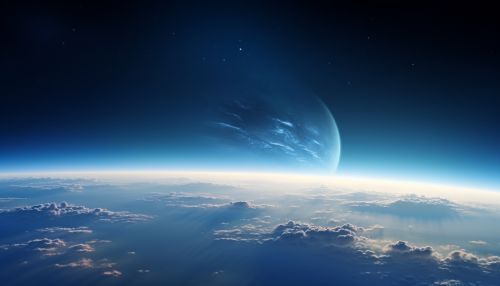Atmosphere of Earth
Composition
The Earth's atmosphere is a layer of gases, commonly known as air, that surrounds the planet Earth and is retained by Earth's gravity. The atmosphere of Earth protects life on Earth by creating pressure allowing for liquid water to exist on the Earth's surface, absorbing ultraviolet solar radiation, warming the surface through heat retention (greenhouse effect), and reducing temperature extremes between day and night (the diurnal temperature variation).
Structure
The atmosphere of Earth is divided into five main layers. These layers are mainly determined by whether temperature increases or decreases with altitude. From highest to lowest, these layers are:
Exosphere


The exosphere is the outermost layer of Earth's atmosphere. It extends from the exobase upward, mainly composed of hydrogen and helium. The particles are so far apart that they can travel hundreds of kilometers without colliding with one another. Since the particles rarely collide, the atmosphere no longer behaves like a fluid. These free-moving particles follow ballistic trajectories and may migrate into and out of the magnetosphere or the solar wind.
Thermosphere
The thermosphere is the second-highest layer of Earth's atmosphere. It extends from the mesopause (which separates it from the mesosphere) to the thermopause at an altitude of about 80 km (50 mi) to 600 km (370 mi) above sea level. The height of the thermopause varies considerably due to changes in solar activity. Because in this layer the temperature increases with increasing height, it is a source of turbulence for aircraft.
Mesosphere
The mesosphere is the third highest layer of Earth's atmosphere, occupying the region above the stratosphere and below the thermosphere. It extends from the stratopause at an altitude of about 50 km (31 mi) to the mesopause at 85 km (53 mi) above sea level. Temperatures drop with increasing altitude to the mesopause that marks the top of this middle layer of the atmosphere. It is the layer where most meteors burn up upon entering the atmosphere.
Stratosphere
The stratosphere is the second-lowest layer of Earth's atmosphere. It lies above the troposphere and is separated from it by the tropopause. This layer extends from the top of the troposphere at roughly 12 km (7.5 mi) above Earth's surface to the stratopause at an altitude of about 50 to 55 km (31 to 34 mi).
Troposphere
The troposphere is the lowest layer of Earth's atmosphere. It extends from Earth's surface to an average height of about 12 km (7.5 mi), although this altitude varies from about 9 km (5.6 mi) at the geographical poles to 17 km (11 mi) at the equator, with some variation due to weather. The troposphere is bounded above by the tropopause, a boundary marked in most places by a temperature inversion (i.e., a layer of relatively warm air above a colder one), and in others by a zone which is isothermal with height.
Physical properties


The physical properties of the Earth's atmosphere vary, such as density and temperature, with altitude. The pressure of the Earth's atmosphere decreases with altitude. At sea level, the average atmospheric pressure is 101.325 kPa.
Chemical composition
The Earth's atmosphere is composed of 78% nitrogen, 21% oxygen, and 1% other gases, including argon and carbon dioxide.
